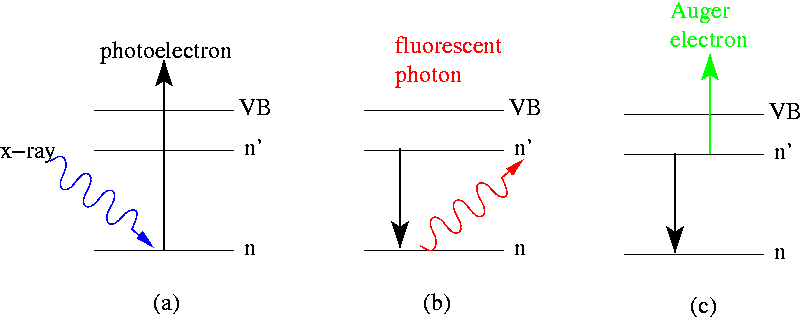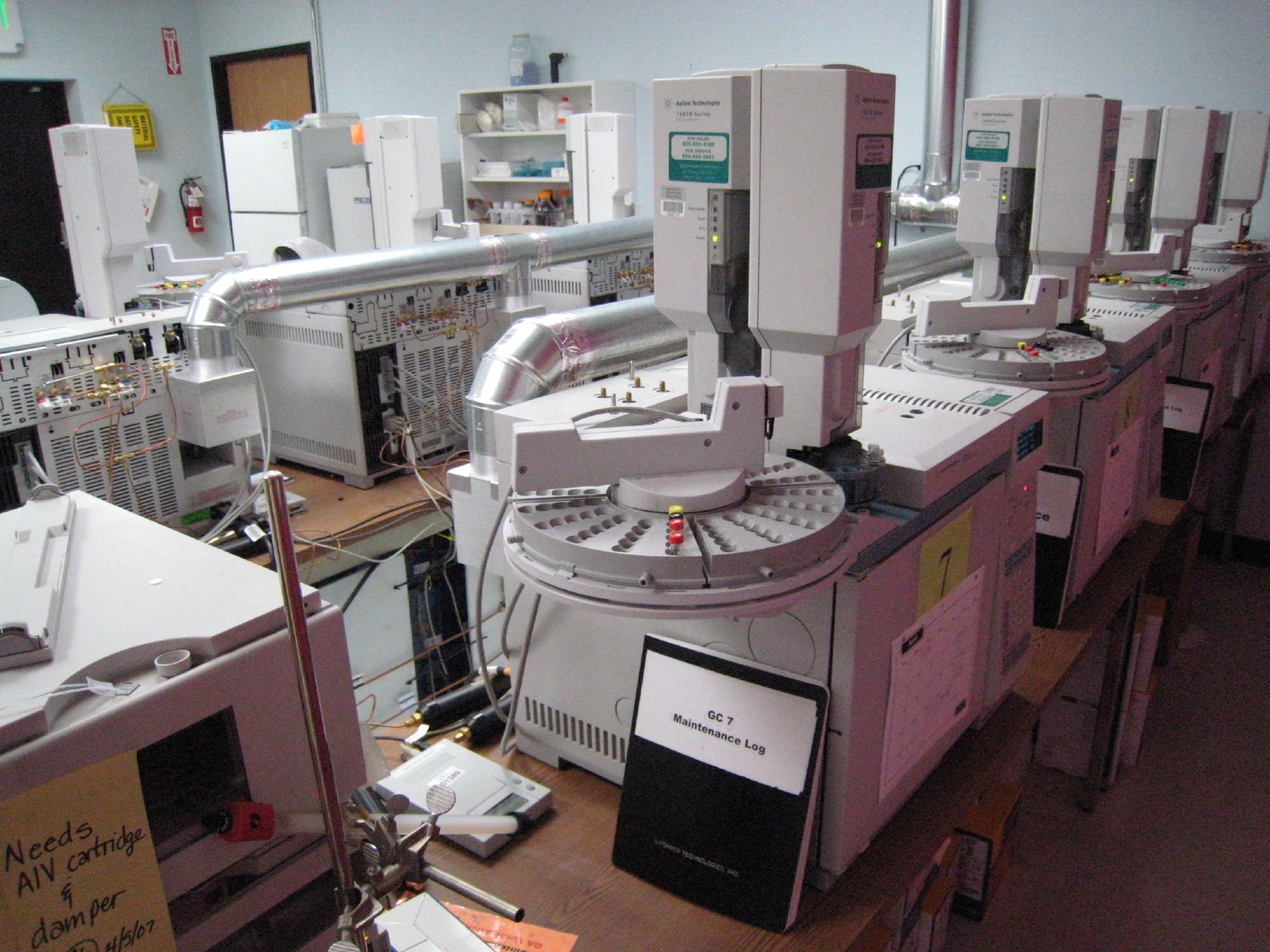|
Electron Spectroscopy
Electron spectroscopy refers to a group formed by techniques based on the analysis of the energies of emitted electrons such as Photoelectric effect, photoelectrons and Auger electrons. This group includes X-ray photoelectron spectroscopy (XPS), which also known as Electron Spectroscopy for Chemical Analysis (ESCA), Electron energy loss spectroscopy (EELS), Ultraviolet photoelectron spectroscopy (UPS), and Auger electron spectroscopy (AES). These analytical techniques are used to identify and determine the elements and their electronic structures from the surface of a test sample. Samples can be solids, gases or liquids.Yang Leng; ''Materials Characterization: Introduction to Microscopic and Spectroscopic Methods (Second Edition)''; Publisher John Wiley & Sons, Incorporated 2013; p: 191-192, 221-224.Daintith, J.; ''Dictionary of Chemistry (6th Edition)''; Oxford University Press, 2008; p: 191, 416, 541 Chemical information is obtained only from the uppermost atomic layers of the sam ... [...More Info...] [...Related Items...] OR: [Wikipedia] [Google] [Baidu] |
Photoelectric Effect
The photoelectric effect is the emission of electrons from a material caused by electromagnetic radiation such as ultraviolet light. Electrons emitted in this manner are called photoelectrons. The phenomenon is studied in condensed matter physics, solid state, and quantum chemistry to draw inferences about the properties of atoms, molecules and solids. The effect has found use in electronic devices specialized for light detection and precisely timed electron emission. The experimental results disagree with classical electromagnetism, which predicts that continuous light waves transfer energy to electrons, which would then be emitted when they accumulate enough energy. An alteration in the intensity of light would theoretically change the kinetic energy of the emitted electrons, with sufficiently dim light resulting in a delayed emission. The experimental results instead show that electrons are dislodged only when the light exceeds a certain frequency—regardless of the ligh ... [...More Info...] [...Related Items...] OR: [Wikipedia] [Google] [Baidu] |
Kai Siegbahn
Kai Manne Börje Siegbahn (20 April 1918 – 20 July 2007) was a Swedish physicist who shared the 1981 Nobel Prize in Physics. Biography Siegbahn was born in Lund, Sweden, son of Manne Siegbahn the 1924 physics Nobel Prize winner. Siegbahn earned his doctorate at the Stockholm University in 1944. He was professor at the Royal Institute of Technology 1951–1954, and then professor of experimental physics at Uppsala University 1954–1984, which was the same chair his father had held. He shared the 1981 Nobel Prize in Physics with Nicolaas Bloembergen and Arthur Schawlow. Siegbahn received half the prize "for his contribution to the development of high-resolution electron spectroscopy" while Bloembergen and Schawlow received one quarter each "for their contribution to the development of laser spectroscopy". Siegbahn referred to his technique as Electron Spectroscopy for Chemical Analysis (ESCA); it is now usually known as X-ray photoelectron spectroscopy (XPS). In 1967 he publ ... [...More Info...] [...Related Items...] OR: [Wikipedia] [Google] [Baidu] |
Work Function
In solid-state physics, the work function (sometimes spelled workfunction) is the minimum thermodynamic work (i.e., energy) needed to remove an electron from a solid to a point in the vacuum immediately outside the solid surface. Here "immediately" means that the final electron position is far from the surface on the atomic scale, but still too close to the solid to be influenced by ambient electric fields in the vacuum. The work function is not a characteristic of a bulk material, but rather a property of the surface of the material (depending on crystal face and contamination). Definition The work function for a given surface is defined by the difference :W = -e\phi - E_, where is the charge of an electron, is the electrostatic potential in the vacuum nearby the surface, and is the Fermi level (electrochemical potential of electrons) inside the material. The term is the energy of an electron at rest in the vacuum nearby the surface. In practice, one directly controls ... [...More Info...] [...Related Items...] OR: [Wikipedia] [Google] [Baidu] |
Ultraviolet Photoelectron Spectroscopy
Ultraviolet photoelectron spectroscopy (UPS) refers to the measurement of kinetic energy spectra of photoelectrons emitted by molecules that have absorbed ultraviolet photons, in order to determine molecular orbital energies in the valence region. Basic theory If Albert Einstein's photoelectric law is applied to a free molecule, the kinetic energy ( E_\text) of an emitted photoelectron is given by : E_\text = h\nu - I\,, where ''h'' is the Planck constant, ''ν'' is the frequency of the ionizing light, and ''I'' is an ionization energy for the formation of a singly charged ion in either the ground state or an excited state. According to Koopmans' theorem, each such ionization energy may be identified with the energy of an occupied molecular orbital. The ground-state ion is formed by removal of an electron from the highest occupied molecular orbital, while excited ions are formed by removal of an electron from a lower occupied orbital. History Before 1960, virtually all ... [...More Info...] [...Related Items...] OR: [Wikipedia] [Google] [Baidu] |
University Of Oxford
The University of Oxford is a collegiate university, collegiate research university in Oxford, England. There is evidence of teaching as early as 1096, making it the oldest university in the English-speaking world and the List of oldest universities in continuous operation, second-oldest continuously operating university globally. It expanded rapidly from 1167, when Henry II of England, Henry II prohibited English students from attending the University of Paris. When disputes erupted between students and the Oxford townspeople, some Oxford academics fled northeast to Cambridge, where they established the University of Cambridge in 1209. The two English Ancient university, ancient universities share many common features and are jointly referred to as ''Oxbridge''. The University of Oxford comprises 43 constituent colleges, consisting of 36 Colleges of the University of Oxford, semi-autonomous colleges, four permanent private halls and three societies (colleges that are depar ... [...More Info...] [...Related Items...] OR: [Wikipedia] [Google] [Baidu] |
Imperial College London
Imperial College London, also known as Imperial, is a Public university, public research university in London, England. Its history began with Prince Albert of Saxe-Coburg and Gotha, Prince Albert, husband of Queen Victoria, who envisioned a Albertopolis, cultural district in South Kensington that included museums, colleges, and the Royal Albert Hall. In 1907, these colleges – the Royal College of Science, the Royal School of Mines, and the City and Guilds of London Institute – merged to form the Imperial College of Science and Technology. In 1988, Imperial merged with St Mary's Hospital, London, St Mary's Hospital Medical School and then with Charing Cross and Westminster Medical School to form the Imperial College School of Medicine. The Imperial Business School was established in 2003 and officially opened by Elizabeth II, Queen Elizabeth II. Formerly a constituent college of the University of London, Imperial became an independent university in 2007. Imperial is o ... [...More Info...] [...Related Items...] OR: [Wikipedia] [Google] [Baidu] |
David W
David (; , "beloved one") was a king of ancient Israel and Judah and the third king of the United Monarchy, according to the Hebrew Bible and Old Testament. The Tel Dan stele, an Aramaic-inscribed stone erected by a king of Aram-Damascus in the late 9th/early 8th centuries BCE to commemorate a victory over two enemy kings, contains the phrase (), which is translated as " House of David" by most scholars. The Mesha Stele, erected by King Mesha of Moab in the 9th century BCE, may also refer to the "House of David", although this is disputed. According to Jewish works such as the '' Seder Olam Rabbah'', '' Seder Olam Zutta'', and '' Sefer ha-Qabbalah'' (all written over a thousand years later), David ascended the throne as the king of Judah in 885 BCE. Apart from this, all that is known of David comes from biblical literature, the historicity of which has been extensively challenged,Writing and Rewriting the Story of Solomon in Ancient Israel; by Isaac Kalimi; pag ... [...More Info...] [...Related Items...] OR: [Wikipedia] [Google] [Baidu] |
Analytical Chemistry
Analytical skill, Analytical chemistry studies and uses instruments and methods to Separation process, separate, identify, and Quantification (science), quantify matter. In practice, separation, identification or quantification may constitute the entire analysis or be combined with another method. Separation isolates analytes. Qualitative inorganic analysis, Qualitative analysis identifies analytes, while Quantitative analysis (chemistry), quantitative analysis determines the numerical amount or concentration. Analytical chemistry consists of classical, wet chemistry, wet chemical methods and modern analytical techniques. Classical qualitative methods use separations such as Precipitation (chemistry), precipitation, Extraction (chemistry), extraction, and distillation. Identification may be based on differences in color, odor, melting point, boiling point, solubility, radioactivity or reactivity. Classical quantitative analysis uses mass or volume changes to quantify amount. Ins ... [...More Info...] [...Related Items...] OR: [Wikipedia] [Google] [Baidu] |
Albert Einstein
Albert Einstein (14 March 187918 April 1955) was a German-born theoretical physicist who is best known for developing the theory of relativity. Einstein also made important contributions to quantum mechanics. His mass–energy equivalence formula , which arises from special relativity, has been called "the world's most famous equation". He received the 1921 Nobel Prize in Physics for . Born in the German Empire, Einstein moved to Switzerland in 1895, forsaking his German citizenship (as a subject of the Kingdom of Württemberg) the following year. In 1897, at the age of seventeen, he enrolled in the mathematics and physics teaching diploma program at the Swiss ETH Zurich, federal polytechnic school in Zurich, graduating in 1900. He acquired Swiss citizenship a year later, which he kept for the rest of his life, and afterwards secured a permanent position at the Swiss Patent Office in Bern. In 1905, he submitted a successful PhD dissertation to the University of Zurich. In 19 ... [...More Info...] [...Related Items...] OR: [Wikipedia] [Google] [Baidu] |
Auger Electrons
The Auger effect (; ) or Meitner-Auger effect is a physical phenomenon in which atoms eject electrons. It occurs when an inner-shell vacancy in an atom is filled by an electron, releasing energy that causes the emission of another electron from a different shell of the same atom. When a core electron is removed, leaving a vacancy, an electron from a higher energy level may fall into the vacancy, resulting in a release of energy. For light atoms (Z<12), this energy is most often transferred to a valence electron which is subsequently ejected from the atom. This second ejected electron is called an Auger electron. For heavier atomic nuclei, the release of the energy in the form of an emitted becomes gradually more probable. Effect Upon ejection, the |
Max Planck
Max Karl Ernst Ludwig Planck (; ; 23 April 1858 – 4 October 1947) was a German Theoretical physics, theoretical physicist whose discovery of energy quantum, quanta won him the Nobel Prize in Physics in 1918. Planck made many substantial contributions to theoretical physics, but his fame as a physicist rests primarily on his role as the originator of Quantum mechanics, quantum theory and one of the founders of modern physics, which revolutionized understanding of atomic and Subatomic particle, subatomic processes. He is known for the Planck constant, which is of foundational importance for quantum physics, and which he used to derive a set of Unit of measurement, units, today called Planck units, expressed only in terms of fundamental physical constants. Planck was twice president of the German scientific institution Kaiser Wilhelm Society. In 1948, it was renamed the Max Planck Society (Max-Planck-Gesellschaft) and nowadays includes 83 institutions representing a wide range ... [...More Info...] [...Related Items...] OR: [Wikipedia] [Google] [Baidu] |






